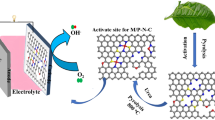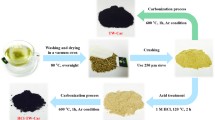Abstract
To commercialize fuel cells and metal-air batteries, cost-effective, highly active catalysts for the oxygen reduction reaction (ORR) must be developed. Herein, we describe the development of low-cost, heteroatom (N, P, Fe) ternary-doped, porous carbons (HDPC). These materials are prepared by one-step pyrolysis of natural tea leaves treated with an iron salt, without any chemical and physical activation. The natural structure of the tea leaves provide a 3D hierarchical porous structure after carbonization. Moreover, heteroatom containing organic compounds in tea leaves act as precursors to functionalize the resultant carbon frameworks. In addition, we found that the polyphenols present in tea leaves act as ligands, reacting with Fe ions to form coordination compounds; these complexes acted as the precursors for Fe and N active sites. After pyrolysis, the as-prepared HDPC electrocatalysts, especially HDPC-800 (pyrolyzed at 800 °C), had more positive onsets, half-wave potentials, and higher catalytic activities for the ORR, which proceeds via a direct four-electron reaction pathway in alkaline media, similar to commercial Pt/C catalysts. Furthermore, HDPC-X also showed enhanced durability and better tolerance to methanol crossover and CO poisoning effects in comparison to commercial Pt/C, making them promising alternatives for state-of-the-art ORR electrocatalysts for electrochemical energy conversion. The method used here provides valuable guidelines for the design of high-performance ORR electrocatalysts from natural sources at the industrial scale.

Similar content being viewed by others

References
Bashyam, R.; Zelenay, P. A class of non-precious metal composite catalysts for fuel cells. Nature 2006, 443, 63–66.
Nagasawa, K.; Takao, S.; Higashi, K.; Nagamatsu, S. I.; Samjeské, G.; Imaizumi, Y.; Sekizawa, O.; Yamamoto, T.; Uruga, T.; Iwasawa, Y. Performance and durability of Pt/C cathode catalysts with different kinds of carbons for polymer electrolyte fuel cells characterized by electrochemical and in situ XAFS techniques. Phys. Chem. Chem. Phys. 2014, 16, 10075–10087.
Liang, Y. Y.; Wang, H. L.; Zhou, J. G.; Li, Y. G.; Wang, J.; Regier, T.; Dai, H. J. Covalent hybrid of spinel manganesecobalt oxide and graphene as advanced oxygen reduction electrocatalysts. J. Am. Chem. Soc. 2012, 134, 3517–3523.
Wen, Z. H.; Ci, S. Q.; Zhang, F.; Feng, X. L.; Cui, S. M.; Mao, S.; Luo, S. L.; He, Z.; Chen, J. H. Nitrogen-enriched core–shell structured Fe/Fe3C-C nanorods as advanced electrocatalysts for oxygen reduction reaction. Adv. Mater. 2012, 24, 1399–1404.
Bezerra, C. W. B.; Zhang, L.; Lee, K.; Liu, H. S.; Marques, A. L. B.; Marques, E. P.; Wang, H. J.; Zhang, J. J. A review of Fe-N/C and Co-N/C catalysts for the oxygen reduction reaction. Electrochim. Acta 2008, 53, 4937–4951.
Gong, K. P.; Du, F.; Xia, Z. H.; Durstock, M.; Dai, L. M. Nitrogen-doped carbon nanotube arrays with high electrocatalytic activity for oxygen reduction. Science 2009, 323, 760–764.
Yang, Z.; Yao, Z.; Li, G. F.; Fang, G. Y.; Nie, H. G.; Liu, Z.; Zhou, X. M.; Chen, X. A.; Huang, S. M. Sulfur-doped graphene as an efficient metal-free cathode catalyst for oxygen reduction. ACS Nano 2012, 6, 205–211.
Qing, X. T.; Cao, Y.; Wang, J.; Chen, J. J.; Lu, Y. P/N/O co-doped carbonaceous material based supercapacitor with voltage up to 1.9 V in aqueous electrolyte. RSC. Adv. 2014, 4, 55971–55979.
Zhang, Y. J.; Chu, M.; Yang, L.; Deng, W. F.; Tan, Y. M.; Ma, M.; Xie, Q. J. Synthesis and oxygen reduction properties of three-dimensional sulfur-doped graphene networks. Chem. Commun. 2014, 50, 6382–6385.
Jeon, I. Y.; Choi, H. J.; Jung, S. M.; Seo, J. M.; Kim, M. J.; Dai, L. M.; Baek, J. B. Large-scale production of edgeselectively functionalized graphene nanoplatelets via ball milling and their use as metal-free electrocatalysts for oxygen reduction reaction. J. Am. Chem. Soc. 2013, 135, 1386–1393.
Huang, C. C.; Sun, T.; Hulicova-Jurcakova, D. Wide electrochemical window of supercapacitors from coffee bean-derived phosphorus-rich carbons. ChemSusChem 2013, 6, 2330–2339.
Song, M. Y.; Park, H. Y.; Yang, D. S.; Bhattacharjya, D.; Yu, J. S. Seaweed-derived heteroatom-doped highly porous carbon as an electrocatalyst for the oxygen reduction reaction. ChemSusChem 2014, 7, 1755–1763.
Liu, S.; Tian, J. Q.; Wang, L.; Zhang, Y. W.; Qin, X. Y.; Luo, Y. L.; Asiri, A. M.; Al-Youbi, A. O.; Sun, X. P. Hydrothermal treatment of grass: A low-cost, green route to nitrogen-doped, carbon-rich, photoluminescent polymer nanodots as an effective fluorescent sensing platform for label-free detection of Cu(II) ions. Adv. Mater. 2012, 24, 2037–2041.
Qian, W. J.; Sun, F. X.; Xu, Y. H.; Qiu, L. H.; Liu, C. H.; Wang, S. D.; Yan, F. Human hair-derived carbon flakes for electrochemical supercapacitors. Energy Environ. Sci. 2014, 7, 379–386.
Chaudhari, N. K.; Song, M. Y.; Yu, J.-S. Heteroatom-doped highly porous carbon from human urine. Sci. Rep. 2014, 4, 5221.
Chaudhari, K. N.; Song, M. Y.; Yu, J. S. Transforming hair into heteroatom-doped carbon with high surface area. Small 2014, 10, 2625–2636.
Li, Y.; Zhao, Y.; Cheng, H. H.; Hu, Y.; Shi, G. Q.; Dai, L. M.; Qu, L. T. Nitrogen-doped graphene quantum dots with oxygen-rich functional groups. J. Am. Chem. Soc. 2012, 134, 15–18.
Cao, R. G.; Thapa, R.; Kim, H.; Xu, X. D.; Gyu Kim, M.; Li, Q.; Park, N.; Liu, M. L.; Cho, J. Promotion of oxygen reduction by a bio-inspired tethered iron phthalocyanine carbon nanotube-based catalyst. Nat. Commun. 2013, 4, 2076.
Zhu, H.; Yin, J.; Wang, X. L.; Wang, H. Y.; Yang, X. R. Microorganism-derived heteroatom-doped carbon materials for oxygen reduction and supercapacitors. Adv. Funct. Mater. 2013, 23, 1305–1312.
Graham, H. N. Green tea composition, consumption, and polyphenol chemistry. Prev. Med. 1992, 21, 334–350.
Chan, E. W. C.; Soh, E. Y.; Tie, P. P.; Law, Y. P. Antioxidant and antibacterial properties of green, black, and herbal teas of camellia sinensis. Pharmacogn. Res. 2011, 3, 266–272.
Saito, S. T.; Welzel, A.; Suyenaga, E. S.; Bueno, F. A method for fast determination of epigallocatechin gallate (EGCG), epicatechin (EC), catechin (C) and caffeine (CAF) in green tea using HPLC. Ciênc. Tecnol. Aliment. (Campinas) 2006, 26, 394–400.
Markova, Z.; Novak, P.; Kaslik, J.; Plachtova, P.; Brazdova, M.; Jancula, D.; Siskova, K. M.; Machala, L.; Marsalek, B.; Zboril, R. et al. Iron(II, III)-polyphenol complex nanoparticles derived from green tea with remarkable ecotoxicological impact. ACS Sustainable Chem. Eng. 2014, 2, 1674–1680.
Akhavan, O.; Bijanzad, K.; Mirsepah, A. Synthesis of graphene from natural and industrial carbonaceous wastes. RSC Adv. 2014, 4, 20441–20448.
Ferrari, A. C.; Robertson, J. Interpretation of raman spectra of disordered and amorphous carbon. Phys. Rev. B 2000, 61, 14095–14107.
Meng, Y. Y.; Zou, X. X.; Huang, X. X.; Goswami, A.; Liu, Z. W.; Asefa, T. Polypyrrole-derived nitrogen and oxygen co-doped mesoporous carbons as efficient metal-free electrocatalyst for hydrazine oxidation. Adv. Mater. 2014, 26, 6510–6516.
Cai, H. M.; Peng, C. Y.; Chen, J.; Hou, R. Y.; Gao, H. J.; Wan, X. C. X-ray photoelectron spectroscopy surface analysis of fluoride stress in tea (Camellia sinensis (L.) O. Kuntze) leaves. J. Fluorine Chem. 2014, 158, 11–15.
Barazzouk, S.; Daneault, C. Amino acid and peptide immobilization on oxidized nanocellulose: Spectroscopic characterization. Nanomaterials 2012, 2, 187–205.
Dake, L. S.; Baer, D. R.; Friedrich, D. M. Auger parameter measurements of phosphorus compounds for characterization of phosphazenes. J. Vac. Sci. Technol. A 1989, 7, 1634–1638.
Wu, J.; Yang, Z. R.; Sun, Q. J.; Li, X. W.; Strasser, P.; Yang, R. Z. Synthesis and electrocatalytic activity of phosphorus-doped carbon xerogel for oxygen reduction. Electrochim. Acta 2014, 127, 53–60.
Titirici, M.-M.; Thomas, A.; Antonietti, M. Aminated hydrophilic ordered mesoporous carbons. J. Mater. Chem. 2007, 17, 3412–3418.
Liu, S. S.; Deng, C. W.; Yao, L.; Zhong, H. X.; Zhang, H. M. The key role of metal dopants in nitrogen-doped carbon xerogel for oxygen reduction reaction. J. Power Sources 2014, 269, 225–235.
Kim, D. W.; Li, O. L.; Saito, N. The role of the central Fe atom in the N4-macrocyclic structure for the enhancement of oxygen reduction reaction in a heteroatom nitrogen-carbon nanosphere. Phys. Chem. Chem. Phys. 2014, 16, 14905–14911.
Byon, H. R.; Suntivich, J.; Crumlin, E. J.; Shao-Horn, Y. Fe-N-modified multi-walled carbon nanotubes for oxygen reduction reaction in acid. Phys. Chem. Chem. Phys. 2011, 13, 21437–21445.
Hu, H.; Zhao, Z. B.; Wan, W. B.; Gogotsi, Y.; Qiu, J. S. Ultralight and highly compressible graphene aerogels. Adv. Mater. 2013, 25, 2219–2223.
Cui, Q.; Chao, S. J.; Wang, P. H.; Bai, Z. Y.; Yan, H. Y.; Wang, K.; Yang, L. Fe-N/C catalysts synthesized by heattreatment of iron triazine carboxylic acid derivative complex for oxygen reduction reaction. RSC Adv. 2014, 4, 12168–12174.
Qu, L. T.; Liu, Y.; Baekand, J. B.; Dai, L. M. Nitrogen-doped graphene as efficient metal-free electrocatalyst for oxygen reduction in fuel cells. ACS Nano 2010, 4, 1321–1326.
Zhang, M.; Jia, M. Q. High rate capability and long cycle stability Fe3O4-graphene nanocomposite as anode material for lithium ion batteries. J. Alloy. Compd. 2013, 551, 53–60.
Shahwan, T.; Abu Sirriah, S.; Nairat, M.; Boyaci, E.; Eroglu, A. E.; Scott, T. B.; Hallam, K. R. Green synthesis of iron nanoparticles and their application as a fenton-like catalyst for the degradation of aqueous cationic and anionic dyes. Chem. Eng. J. 2011, 172, 258–266.
Wang, W. P.; Yang, H.; Xian, T.; Jiang, J. L. XPS and magnetic properties of CoFe2O4 nanoparticles synthesized by a polyacrylamide gel route. Mater. Trans. 2012, 53, 1586–1589.
Yan, X. D.; Liu, Y.; Fan, X. R.; Jia, X. L.; Yu, Y. H.; Yang, X. P. Nitrogen/phosphorus co-doped nonporous carbon nanofibers for high-performance supercapacitors. J. Power Sources 2014, 248, 745–751.
Liu, Z. W.; Peng, F.; Wang, H. J.; Yu, H.; Zheng, W. X.; Yang, J. Phosphorus-doped graphite layers with high electrocatalytic activity for the O2 reduction in an alkaline medium. Angew.Chem.Int. Ed. 2011, 50, 3257–3261.
Dou, S.; Shen, A. L.; Ma, Z. L.; Wu, J. H.; Tao, L.; Wang, S. Y. N, P and S-tridoped graphene as metal-free electrocatalyst for oxygen reduction reaction. J. Electroanal. Chem. 2015, 753, 21–27.
Zhu, J. L.; Jiang, S. P.; Wang, R. H.; Shi, K. Y.; Shen, P. K. One-pot synthesis of a nitrogen and phosphorus-dual-doped carbon nanotube array as a highly effective electrocatalyst for the oxygen reduction reaction. J. Mater. Chem. A. 2014, 2, 15448–15453.
Zhuang, G. L.; Bai, J. Q.; Tao, X. Y.; Luo, J. M.; Wang, X. D.; Gao, Y. F.; Zhong, X.; Li, X. N.; Wang, J. G. Synergistic effect of S, N-co-doped mesoporous carbon materials with high performance for oxygen-reduction reaction and Li-ion batteries. J. Mater. Chem. A 2015, 3, 20244–20253.
Author information
Authors and Affiliations
Corresponding authors
Electronic supplementary material
Rights and permissions
About this article
Cite this article
Guo, Z., Xiao, Z., Ren, G. et al. Natural tea-leaf-derived, ternary-doped 3D porous carbon as a high-performance electrocatalyst for the oxygen reduction reaction. Nano Res. 9, 1244–1255 (2016). https://doi.org/10.1007/s12274-016-1020-2
Received:
Revised:
Accepted:
Published:
Issue Date:
DOI: https://doi.org/10.1007/s12274-016-1020-2



